

The Rover 75 : From the Eyes of a Honda Fan
Last month I was invited to attend a media test-drive session for the newly launched Rover 75 and MG ZT . This was hosted by Brooklands Motors who is the local representative for the MG Rover Group here in Malaysia. For this particular media test-drive session, I was given the opportunity to test three very interesting models : the Rover 75 1.8 Turbo, the Rover 75 2.0 V6 and the intriguing MG ZT 260. It was a unique experience to sample what the competition are offering against our Honda models, and it was certainly eye-opening as well. In this review, I will cover my experience and impressions of the two Rover 75 sedans. The MG ZT however deserves to be given it's own dedicated coverage in a follow-up review.
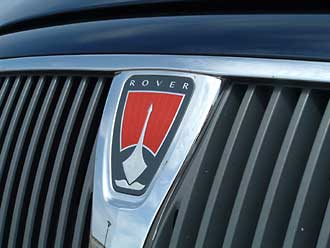
I did a quick research on the internet prior to writing this article, to get an understanding of Rover's history. Rover has a really long history, dating way back to the beginning of the last century. According to internet resources, the Rover Group of today was created back in 1986 when Graham Day was appointed British Leyland's chairman, the then parent company of Rover. He also started the move of Rover cars to target the more specialized 'up-market luxury' segment, and the segregation of 'family sedans' as Rovers and the reservation of the MG marque for their performance models.
Actually Rover and Honda are not unfamiliar to each other - they had a period of collaboration from 1977 to 1994, a period of 17 years. This was initiated by Michael Edwardes who was the predecessor to Graham Day from 1977 to 1986 and was a collaboration which Graham Day continued until the takeover by BMW in 1994. The collaboration produced a number of interesting and well built cars, for me the most memorable was the Rover 220i Coupe, a 2.0l DOHC Turbocharged sports-coupe with 190ps and a standing start quarter-mile times of less than 15 seconds !
BMW decided to sell the business in 2000 and in the process split up the components of the Rover Group, selling Land Rover to Ford, but keeping the Mini for themselves. The remainder of the group which comprises the core passenger car business headed by the Rover and MG marque finally fell back into british control on May 9th 2000, now called the 'MG Rover Group'. This was achieved by a group of british businessmen who formed the Phoenix Consortium, headed by an ex-Rover executive by the name of John Towers. Amazingly they actually bought MG Rover Group back from BMW for a paltry sum of only ten pounds ! And of course, this is how the icon of british small cars, the Mini, came about to be owned by a German manufacturer.
The subject of this review, the Rover 75 was launched in 1998, envisioned to be the 'best FWD saloon in the world' and today serves as the flagship saloon in the MG Rover Group line-up. Currently a three variants line-up is being marketed in Malaysia, the 1.8 Turbo and 2.0 V6 that I had the chance to test-drive and also a 2.0 CDTi (Turbo-Diesel).
Rover 75 1.8 Turbo and 2.0 V6 : Brief Technical Overviews
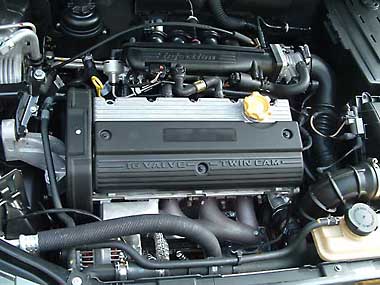
The mechanical difference between the Rover 75 1.8 Turbo and 2.0 V6 are mostly in their engines. Despite its smaller engine, it seems to me that the 1.8 Turbo is the 'sportier' of the two, the 2.0 V6 more of a family-oriented luxury sedan. The local Rover website makes reference to 'sparkling performance' and 'generous pulling power' for the 1.8 Turbo while the 2.0 V6 is slated as an 'executive car' emphasizing 'efficient power delivery' and 'lower fuel costs'. Needless to say the 1.8 Turbo also has better acceleration times compared to the 2.0l.

The 1.8 Turbo as it name suggests uses a Rover designed 'K-series' 1.8l DOHC EFi engine equipped with a turbocharger and intercooler. This is a so-called LPT or Low Pressure Turbo application whereby the turbocharger is run at moderate levels of boost. This gives relatively small gains in max power and is instead used to deliver a torque curve 'close to the ideal flat profile' (in Rover's own words). According to the Rover people, they estimate the boost levels to be around 0.5 to 0.6 bar and this works with a rather high CR of 9.2 (quite typical of LPT engines) to generate a max power of 150hp at 5,500rpm. Red-line is quite high at 6800-7000rpm while max torque is a very high 215Nm or 21.9kgm coming in at a low 2,100rpm. This kind of max torque level means the 1.8l is delivering as much torque as engines that are 40-50% larger in size, quite the norm for LPT'ed engines. The 1.8 Turbo delivers quite peppy performance, with an official spec'ed time of 9.7 seconds for the 0-100kph (0-63mph) sprint and a rated top speed of 204kph (127mph).

The Rover 75 2.0 V6 comes with a natural aspirated 2.0l V6 engine. This is a straight-forward 'quad-cam' or QOHC-V6 design (i.e. both banks of 3 cylinders running in DOHC configuration) running at a high CR of 10.5 and delivering the same 150hp max power as the 1.8 Turbo but coming in at a higher 6,500rpm. Interestingly, the redline is actually lower than for the 1.8 Turbo, the ]tachometer tagging the redline at 6700rpm despite the higher rpm for max power. Max torque is 185Nm (18.9kgm) down by almost 25% when compared to the 1.8T and comes in at a higher 4,000rpm. Not surprisingly, the 2.0 V6 is rated for a slower 10.8 sec for the 0-100kph dash though the rated top speed is the same 204kph.
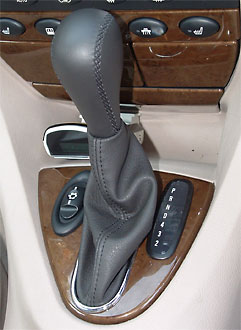
The rest of the car for both variants are more or less identical. Both variants are fitted with a 'JATCO' 5speed automatic gearbox. This is well equipped, fitted with four forward gates : 2, 3, 4 and 'D'. In addition, the gearbox has 3 modes; economy, sports and winter. All these gives the engine-gearbox combo a great deal of flexibility to handle most driving conditions. The suspension system is the standard front strut rear independent system, the front using Macpherson strut and coil spring while the rear is a 'Z-axle' independent system also using coil spring and damper with 'anti-quat and anti-dive geometry'. Front and rear anti-roll bars are fitted. The brake system is the standard front ventilated and rear solid disc combination and is augmented with a Borsch 4-channel ABS with EBD. Both the test-drive cars were fitted with optional 17" wheels with 215/50 R 17 tyres.
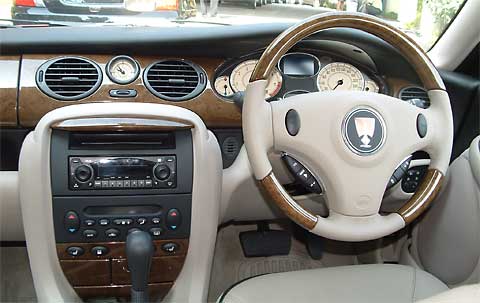
Interior wise, the car is a showcase for 'british design'. In a way, it is an exemplary example of what might be called 'classic british styling'; fully leathered, plenty of wood and chrome trimmings but done with little hint of going overboard. This seems to be something which the european manufacturers are good at doing and is an area which leading Japanese manufacturers like Honda and Toyota have only just began to be good at.
Size-wise, the Rover 75 measures at 4749mm by 1761mm by 1393mm (L X W X H). This places it in between the Honda Civic and Accord in size and price-wise Rover 75 1.8 Turbo is priced very close to the Accord 2.0 i-VTEC while the 2.0 V6 is similar to the Accord 2.4 i-VTEC. Given its CBU (fully imported) status as compared to the CKD (locally assembled) status of the Civic and Accord, in terms of market segment the Rover 75 1.8 Turbo and 2.0 V6 would logically compete against mainly the Accord 2.0 i-VTEC with a few potential buyers perhaps also cross-shopping the Rover 75 1.8 Turbo against the Civic 2.0 i-VTEC. So in this article, it would be most logical to compare both the Rover 75 variants to the Accord 2.0 i-VTEC.
Test-Drive Impressions

The test-drive route given by Brooklands Motor was the recently opened 'East-West' Highway which as its name suggests connects the east and west coasts of peninsula Malaysia. This is a relatively lightly used expressway of mostly 4 lanes in width (2 lanes each way) and would allow the high-speed touring capability of 'continental' cars to shine. Most of the test cars were shared by 4 motoring journalists, each of us taking turns to drive part of the way, around 80-100km each person. For the 1.8 Turbo, I took the '2nd stint' which involves mostly expressway roads. Part of the route however also went through a mountain range and so there were some uphill climbs as well. For the 2.0 V6 however, the group I was in was given the opportunity to take two units of it on our way back. So my experience with the Rover 75 2.0 V6 was more extensive as I was able to take the car over a mixture of trunk roads which required quite a bit of overtaking and I was also able to sample it on the expressway.
Covering the Rover 75 1.8 Turbo first, when I took over the wheels, the first thing I could test was its pickup ability. Accelerating out of the petrol station which served as the drivers changeover point and also a toll gate a little bit further down the road, the 1.8 Turbo picked up speed well despite having the weight of 4 adults on board. We quickly reached the speed limit (110kph or 75mph) and accelerating beyond that to higher speeds, 140kph, 160kph, and more was done without fuss, the pickup beginning to wane after 180kph. The ample low-end and midrange power of the turbocharged engine was very obvious and despite the advertising that the 1.8l DOHC Turbo has the 'ideal flat profile' for its torque curve, there is clearly more pull from the engine around the 'mid-range' region of 3,000-5,000rpm with a clear drop in acceleration after around 5,500rpm. This actually contributes to good pickup during high-speed cruising because when the gearbox is in 5th and the speed is around 100-120kph, the engine spins nicely in the fat midrange and the huge torque allows the engine to breeze its way upwards.

Strangely, when accelerating from standstill I find the gearbox shifts quite a bit early. Engine revs were nowhere near the redline of 6800rpm, the gearbox executing shifts generally once the engine exceeds 6,000rpm, perhaps to exploit the fat midrange of the engine. In the uphill sections of the expressway, the gearbox generally refused to downshift even when the uphill gradient was steep enough that the engine was clearly beginning to strain. We were actually starting to lose speed but the gearbox still kept to the same gear. This behavior was the same irregardless of whether I was in 'economy' or 'sports' mode. Nevertheless, by easing off the throttle and then ramming it down again quickly, what some calls the 'kickdown' sequence, I could get the gearbox to downshift so it wasn't a big issuet.
As for the Rover 75 2.0 V6, I got the chance to take the wheels right away as we depart for our return journey and I had to drive it through town traffic and then a several kilometers stretch of country back roads before we could get onto the East-West highway. As usual, plying those roads included interesting 'obstacles' like slow moving cars who seems to be out for a Sunday drive (eventhough it was a working week-day) as well as slower moving lorries.
Based on its paper specifications, the 2.0 V6 engine should have a wider but generally weaker power band than the 1.8 Turbo. This is shown by the higher rpm points for max torque and max power, both points also being nearer the engine's redline but with the 2.0l engine having much lower torque. So there will definitely be no 'fat midrange' and the engine should feel smooth and pull consistently all the way to the redline though at a lesser rate than the 1.8 Turbo. This was exactly how the Rover 75 2.0 V6 felt to me.
In the narrow trunk-road section of the return journey before getting onto the expressway, by putting the gearbox into S-mode, I was able to overtake the slower vehicles easily. While there was no 'initial push' from a fat midrange, the engine pulled steadily all the way to the redline. So while I had to be a bit more patient during overtaking because there was no urgent initial rush once I had committed to overtake, it was still safely done because the engine pulls steadily during the whole sequence. In S-mode, the gearbox functions as a 4-speed, ignoring the final (5th) gear but for those who still finds the delay for the downshift at kick-down to be a bit annoying for overtaking, the gearbox offers a '2' gate and pre-shifting into this gate right before overtaking will bypass the downshift delays. Once in '2', the car would accelerate forward steadily the moment the throttle is engaged and this allowed overtaking to be done even in the tighter situations, where the incoming traffic is quite heavy.
Then it was time to pay yet another toll at yet another toll-booth. Accelerating away from the toll gate, this time the Rover 75 2.0 V6 shifted nicely and right at the redline. There was a nice typical 'V6 whine' from the engine, so aurally the engine delivers as well. With the 2.0 V6, I also found that the gearbox 'knows' to automatically downshift when going uphill without the need to manually intervene via manipulation of the throttle. By comparison, it actually felt as if the Rover 75 1.8 Turbo I tested the day before could well have had a loose throttle cable and we were not engaging true WOT even with the throttle all the way to the floor.
As would be expected, both Rover 75 variants, the 1.8 Turbo and 2.0 V6 simply excelled on the expressway. We were regularly cruising beyond the speed limit, mostly around 150-160kph and the cars felt stable and ride comfort was really excellent. Despite having a 4 full adults load, neither felt like it had to strain to reach and sustain the high speeds. Acceleration from 'slower' speeds of 100kph or so up to quite high speeds exceeding 160kph or more were done without any strain or fuss. Like the old adage goes, we were literally flying along the highway at speeds beyond 160kph before we even realized we had reach such speeds. What impressed me most however was their suspensions which clearly emphasizes a balance of handling and high speed comfortable cruising. Undulations are dampened out and all road unevenness nicely isolated out. Coupled with very good sound proofing, the car's composure at high speed was such that it did not feel fast and felt very stable even during very high-speed cruising. This is a very clear illustration by the Rovers what is meant when their owners enthused about the 'high speed cruising abilities' of 'continental' (European) cars.
Rover 75 vs Honda Accord : Quick Comparison Notes
Market segmenting-wise with regards to Honda models, the Rover 75s are competing head-on against the Honda Accord 2.0 i-VTEC. In terms of technical specifications and design objectives, both the Rover 75 1.8 Turbo and 2.0 V6 are actualled spec'ed for identical max-power as the Honda Accord 2.0 i-VTEC. In terms of design objectives, they are similar as well, all three being designed as higher-end luxury oriented large sedans. Such large sedans tends to have only slightly better than average pickup but exemplary high-speed cruising abilities.
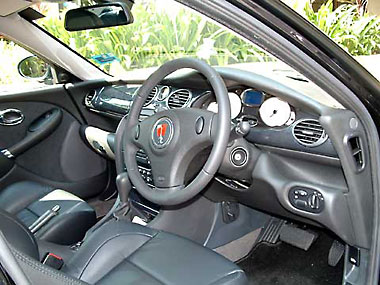 Rover 75 1.8t cabin in 'Contemporary SE' option |
 Rover 75 2.0l cabin in 'Connoisseur SE' option. |
 Interior of the Accord 2.4 i-VTEC. This gives an illustration of
the 2.0 i-VTEC interior with the leather option.
Interior of the Accord 2.4 i-VTEC. This gives an illustration of
the 2.0 i-VTEC interior with the leather option. |
In terms of physical size, the Accord is quite a bit larger than the Rover 75. This carries into the interior as well and for a change, now it is the japanese sedan which has a larger cabin than the continental one. Both Rover 75 variants comes with the optional 'SE' trim. The Rover 75 1.8 Turbo I tested has the Contemporary SE interior, i.e. a predominantly black interior with 'Black Oak' trim. Base 'Contemporary' actually comes with black cloth trimmed seats and the SE option replaces it with black leather seats. The Rover 75 2.0 V6 came with the Connoisseur SE interior, a 'Light Oak' themed interior with the SE option again replacing the clothed seats by light beige coloured leathered ones. In comparison, the Honda Accord 2.0 i-VTEC comes with a beige-dark brown dual tone interior with standard cloth finishing and like the 'SE' option of the Rover 75s, leather is an (dealer) option. Again, out of the norm, the interior cabin space, especially headroom is better on the Accord 2.0 i-VTEC than the Rovers.
In the area of the engine, all three cars, the Rover 75 1.8 Turbo, the Rover 75 2.0 V6 and the Honda Accord 2.0 i-VTEC uses quite different technologies. It's DOHC-Turbo versus QOHC V6 versus DOHC i-VTEC. So all three engines have their unique characteristics and it becomes a matter of personal preference which is the more desirable engine. Specs-wise, the Accord's 2.0l DOHC i-VTEC is rated at 150ps at 6,000rpm with a max torque of 186Nm (19.0kgm) at 4,500rpm. So the Rover 75 V6's 2.0l QOHC V6 have very similar specs to it, with identical max power and near identical max torque and even their respective rpm points are very similar too. So in terms of engine feel, both Rover 75 2.0l and Accord 2.0 i-VTEC really do feel similar, with the Accord subjectively having just a slightly better pull in the lower rpms. Compared with the 1.8 Turbo, the Accord's 2.0l i-VTEC has a wider and flatter power band. So though it is of course no match for the fat midrange of the 1.8l DOHC Turbo, just like the 2.0l QOHC V6, the power delivery is more consistent right up to the redline. The difference really is in their gearboxes. It is probably personal preference here but I feel the Accord's gearbox shifts smoother. Its gear ratios also feels shorter too mainly in the lower gears with the result the Accord 2.0 i-VTEC feels more urgent when pulling in 1st and 2nd gears. The GLC certainly works better than the 1.8 Turbo's gearbox and just like the 2.0 V6, it will downshift when going up steep inclines. In terms of engine note, again the different technologies used gives each its unique sound, the muted growl of the DOHC Turbo is in large contrast to the whine of the QOHC V6 while the Honda DOHC i-VTEC gives a nice throaty roar quite unique to Honda VTEC engines.
Finally on to the area of the suspension. Here I have to say that the Rover 75s have quite clearly better high speed cruising poise than the Accord. In comparison, the Accord's suspension feels just a tad too 'soft' at high speeds and the car tends to have quite a bit of movement over uneven road surfaces. The Rover 75s however are exemplary examples of continental high speed cruising. Their suspension seems to strike a very nice balance between dampening out road unevenness and shielding surface imperfections and yet reducing body movement to a minimum. In terms of wind and tyre noise, the Rovers and the Accord are actually quite similar so it is clearly the suspension tuning which is better implemented on the Rovers. But I need to highlight that the Accord is also very good in this department, just that the Rovers are better. So while the top Japanese manufacturers are getting there. unfortunately the magic 'continental ride' quality is ultimately still elusive, even on the latest generation Honda Accord which already has a really excellent suspension.
Conclusion
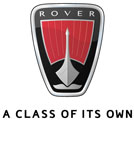
There is a saying that goes something like In order to improve on one's ownself, it is important to first understand the 'enemy'. As a Honda fan, I find this saying to be most appropriate in this review. Rover has a very long and illustrated history so I would say the Rover 75s are some of the toughest competitors the Honda Accord will have to face.
And this Rover 75 test drive is most definitely a very instructive one for me. It serves to remind me of two things. From the angle of a Honda fanatic, I am reminded that the competitions are very strong. Indeed in some aspects, they can be an 'eye-opener' because there is clearly some work left for Honda to do to catch up in all areas, excellent though we are in many. From the other angle however, I am also quite elated to say that in the elusive area of suspension tuning, Honda is no longer lagging as far behind as before and that it can compete quite well with the best that the competition can offer eventhough in the ultimate standard we are still not completely there yet.
Wong KN
November 2004
© the Temple of VTEC Asia